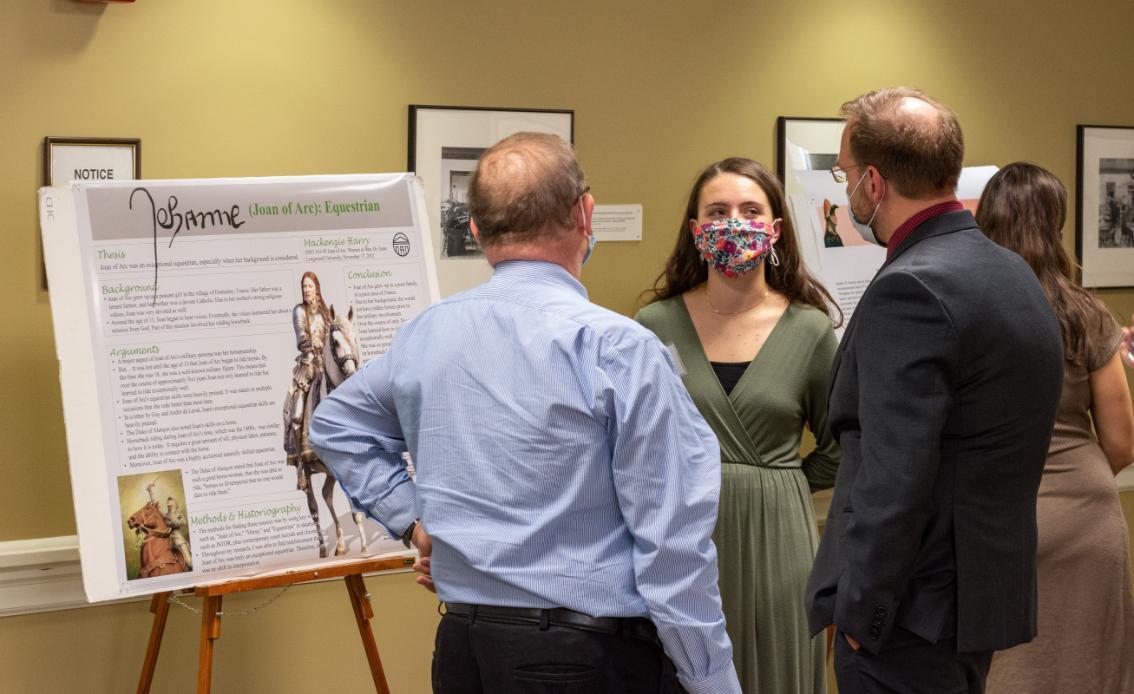The Fall Student Showcase for Research and Creative Inquiry was held on November 17 and featured more than 200 student presentations from class research and independent research projects. This year’s hybrid event featured a mix of virtual presentations and in-person poster sessions, oral presentations and discussions.
Conducting student research is a hallmark of a Longwood education, whether it takes place in a chemistry lab or a dance studio. Undergraduates who undertake research gain confidence to work independently, experience in working collaboratively and develop better communication skills.
[Find out more about student research opportunities at Longwood.]
Here are eight interesting things we learned from Longwood students’ research projects, in no particular order:
1. Joan of Arc a natural equestrian
Joan of Arc had a natural talent for riding horses and a major aspect of her military persona was her horsemanship. She learned how to ride horses exceptionally well, despite her non-wealthy upbringing that would have limited her exposure to horses prior to her military involvement. Mackenzie Harry ’23, HIST 415-50 Joan of Arc: Women at War, Dr. Steven Isaac
2. Therapy dogs aid cancer patients
The use of therapy dogs for patients undergoing chemotherapy treatments can lead to decreased anxiety and symptoms of depression. Brooke Buchanan ’23 & Leah Eick '22, NUR360, Dr. JoAnn Davis
3. Marginalized heroes of the American Revolution
The colonial government promised incentives such as liberty and land to marginalized groups in exchange for military service. Examples such as the Oneida tribe, the 1st Rhode Island Regiment and soldiers Deborah Sampson and Salem Poor played crucial military roles in the victory of the American Revolution. However, in the aftermath of the war these marginalized groups experienced betrayal by the new United States government through land agreements, the maintenance of the internal slave trade and the forced return to domesticity. Haley Smith ’22, HIST 407 The U.S. in the Age of Atlantic Revolutions, Dr. David Geraghty
4. Songs help teach geometry
Did you know that songs can help students remember geometrical shapes? Music and elementary geometry both require knowledge of using symbols and shapes. Incorporating music into lessons for elementary geometry is a non-traditional way of learning that will improve student retention and deepen understanding of the material. Julia Adams ’22 & Maelyn Garrison ’22 , THEA 448, Dr. Rhonda Scarrow
5. Pesticides and plant growth
While pesticides are commonly applied to garden plants to reduce pest damage, they can negatively impact plant growth. In an experiment testing the effects of Sevin, a widely-used pesticide, on cucumber plants, higher pesticide concentration correlated to decreased plant growth. Emma Boeckle '25, Shyane Reyes '25 & Haley Skowysz '25, BIO114, Dr. Mary Lehman
6. What makes a hero?
There are both biological and psychological factors that determine whether someone is likely to become a hero. Heroes are selfless and complex and there is evidence that people who are born with larger amygdalae are more compassionate and more likely to perform heroic acts. Mackenzie Harry ’22, LDST 320, Cormier Honors College Project “What Makes a Hero?,” Dr. Scott Cook
7. RSA and neuromuscular fatigue
Repeat Sprint Ability (RSA) is a key performance factor in many team sports. A pilot study of the effects that a Repeated Sprint Exercise (RSE) has on neuromuscular fatigue sought to understand the factors that influence an individual’s RSA, which is necessary to improve athlete performance. Noel Preece ’22, PRISM Research “Effects of Repeat Sprint Exercise on EMG Activity in Leg Muscle Groups Among a Variety of Athletes: A Pilot Study,” Dr. Robert Blaisdell
8. The role of the French Revolution in today’s politics
The French Revolution cemented the first set of political parties -- the Federalists and the Democratic-Republicans -- into their position in American culture. The policy divisions between the two American political parties created during the period of the French Revolution set the tone for the next 120 years with regards to international affairs. Michael Bell '22, HIST 407 The U.S. in the Age of Atlantic Revolutions, Dr. David Geraghty



Leave a Comment